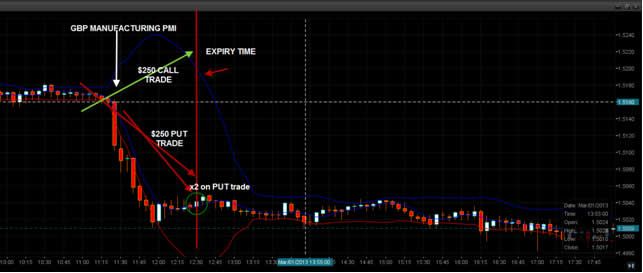Hedging strategies are particularly useful when traders expect increased price action on an asset but are uncertain as to the direction. This often takes place when important economic information is due to be released. Quite often the markets have some anticipation of the how close to the foretasted figures the news will be, but they can also be taken by surprise. Hedging strategies are perfect in these instances and involve taking two opposing positions. In the example presented below both CALL and PUT trades are locked in before the release of British Manufacturing PMI. The figures come in lower than expected and predictably GBP begins to take a dip. As soon as this occurs the trader locks in a second PUT trade for the same expiration time in an attempt to negate the losses of the CALL trade and extend profits.

A thing to keep in mind is that hedges will only work if you have enough time to enter the trades required to balance the losses incurred by one of your initial trades. It is also important to set your expirations long enough to give you the time to enact your hedging strategy appropriately. Binary options give you the freedom to do just this. As you can see from the above screenshot the expiry is set to an hour after the time of the data release, providing more than enough time to ascertain which way the market is moving and to double up on the successful PUT trade. Also, depending on the confidence the trader has in the trend continuing all the way to up expiration, a larger sum can be placed on this second trade.
Hedging sometimes gets a bad name due to it being considered counterproductive to invest capital in a losing position. What people fail to realise is that going in early, on both sides, gets you a better deal in terms of the strike price, which you won’t be able to secure after the trend has fully emerged. Nevertheless it is best not to go into every trading situation looking specifically to hedge. Hedging is a useful tool at times when great movement is expected but the direction is unclear. It can also be used to minimise the effects of a losing trade. After all, winning one or two of three trades is better than winning zero of one. If the above trader had only purchased a CALL option before the data release and then immediately found the market going the other way, the position could still have been hedged by the placement of a couple of subsequent PUT trades, albeit at a less attractive strike price.

















